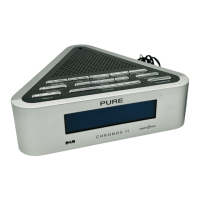
Do you have a question about the PURE CHRONOS II and is the answer not in the manual?
| RMS rated power | 1.7 W |
|---|---|
| Radio type | Clock |
| Tuner type | Digital |
| FM band range | 87.5 - 108 MHz |
| Supported radio bands | DAB |
| Radio Data System (RDS) | Yes |
| Preset stations quantity | 20 |
| Number of built-in speakers | 1 |
| Display type | LCD |
| Product color | Silver |
| Headphone connectivity | 3.5 mm |
| Output | stereo |
| I/O ports | 1 x Mini USB |
| Dimensions (WxDxH) | 170 x 190 x 60 mm |
| Power requirements | 230V AC |
| Power consumption (standby) | 0.99 W |
| Power consumption (typical) | 2.02 W |
Essential safety guidelines for operating the radio, covering heat, water, and proper usage.
Covers aerial setup, power connection, and configuring the energy saving mode.
Details the headphone socket located on the top of the unit.
Describes power/USB sockets (underneath) and brightness settings (rear).
Instructions for selecting between DAB and FM radio reception modes.
How to tune into DAB and FM stations using manual tuning and scanning.
Guide to pausing and navigating scrolling text information displayed on the radio.
How to cycle through and view different data displays on the radio screen.
Steps to save and recall favorite radio stations using the preset function.
Overview of the different settings and options available for alarms.
Step-by-step guide to setting a new alarm, including time, days, and mode.
Choosing the frequency for alarms: daily, weekdays, weekends, specific days, or once only.
Choosing alarm type (DAB, FM, Tone) and selecting a station or last tuned.
Adjusting the volume level for the alarm sound from 1 to 20.
How to cancel alarms, snooze temporarily, and cancel a snoozed alarm.
Adjusting the duration of the snooze interval for alarms.
Using the snooze button to briefly illuminate the radio display.
How to set and cancel the radio's sleep timer for automatic standby.
Guide to accessing on-demand text information like news and sports.
Settings for managing Intellitext data, including timeout and clearing.
Adjusting Dynamic Range Control and configuring station list display.
Scanning for and adding new DAB stations automatically to the station list.
Choosing between stereo and mono audio output for FM broadcasts.
Configuring energy saving options to reduce standby power consumption.
Information on firmware upgrades and setting the clock and date.
Understanding secondary/inactive stations and resolving common issues.
Procedure for resetting the radio and key technical specifications.
List of registered trademarks associated with the product and its manufacturer.
Manufacturer's statements regarding warranties and liability.
Instructions for proper disposal of the product to protect the environment and conserve resources.
Details of the product's warranty coverage, duration, and exclusions.
Contact numbers, email addresses, and website for customer support.
Information about the product's environmental features and recycled materials.